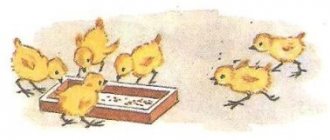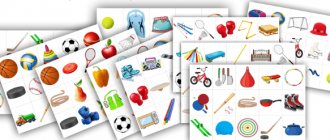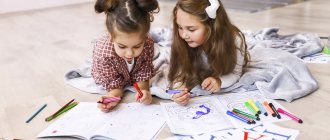Kids learn everything through play. If you want your child to quickly memorize letters and learn to read, come up with fun educational toys. And it’s not at all necessary to buy expensive manuals and look for a tutor. You can do everything yourself. Learn the alphabet anytime, anywhere! Play with letters and your child will remember them in no time.
3ladies.su
What to do if a child does not want to learn letters? Can't remember the alphabet?
First rule: don't force it! Make learning feel like a fun game rather than boring cramming.
The more varied the activities, the faster the child will learn letters and learn to read. Be patient! Study regularly and do not overload your baby with information. 10 minutes a day and several lessons a week are enough for your child to confidently move towards his goal, and for you to rejoice at his successes and achievements.
Let's make letters
Children love to sculpt. Offer them dough, plasticine, clay, wet sand and anything that can somehow hold a given shape. Modeling develops fine motor skills, thinking, and speech. The mind, as you know, is at your fingertips.
alwaysbusyama.com
You should not sculpt several letters at once. One is enough. Letters can be decorated with beads, beans, and peas. If you made it from salt dough, you can bake it and paint it with gouache.
We recommend reading:
- Homemade plasticine: recipes for modeling mass
In parallel with modeling, come up with other tasks to reinforce the recognition of the letter being studied.
Decided to bake cookies? Invite your child to make and then eat his own letter. You can bake several letters with different fillings, and then taste which one tastes better. For example, “A” - with apricot, “K” - with cinnamon, “I” - with apple jam, etc.
alwaysbusyama.com
Ready-made cookies in the shape of letters are available for sale. You can even form words from it.
whatican.ru
Methods for teaching preschoolers to read at home
There are effective methods for teaching children in preparation for school. The most popular of them are described below.
Traditional technique
Classical methods can be used to teach preschoolers. It is based on the following:
- The learning procedure uses cards with letters on them. It is important that the image is colorful and bright. For letters, the background should be inconspicuous and not attract attention. As they study, such cards are attached to the wall in the child’s playroom or in other prominent places. This is necessary so that the baby gets used to them and develops visual memory.
- It is recommended to choose 10 vowels as the very first letters to study. It is believed that at first they are easier to master than consonants. When training is carried out, they not only need to be named, but also sung in order for the child to master it better.
- When learning letters, you need to use not the name, but what sound they correspond to. For demonstration, you can make the sound last longer if possible.
- When studying consonants, it must be borne in mind that some of them are more difficult to perceive and repeat than others. It is recommended to start with mastering T, G, N, M, B, P, K. These letters are easier for a child to master. Sh, Shch, Ch or R in most cases cause more difficulties.
- During intensive classroom teaching, situations may arise when the child is tired and has difficulty learning the material. In this case, there is no need to put pressure on him. We need to give him a rest, and then continue his training with renewed vigor.
- It is important not to limit your activities to your home environment. The child should be encouraged to look for letters he knows when walking on the street in the names of stores or on advertisements.
Note! It is important that learning takes place in a calm and friendly environment. The baby needs to be encouraged and praised, noting his successes, helping to develop skills.
Zaitsev cubes
When studying individual letters, sometimes a situation arises when the letters are already known, but it is not yet possible to form words from them. The author who created this technique believes that learning letters from cards with pictures is harmful to a child’s development.
Zaitsev illustrates this with the following example. For the letter Z, a zebra is depicted on the card. Similar pictures accompany other letters. In this case, the problem arises of how to explain to a child that four cards (zebra, eagle, rhinoceros and tiger) together mean “umbrella”.
According to Zaitsev’s method, several channels of information are used to teach children:
- The cubes vary in size.
- Images of letters are printed using five different colors, which makes it impossible to confuse them.
- Using different materials to make cubes results in different sounds when played with. Some are metal and others are wooden.
Note! Zaitsev divides words not into letters, but into warehouses. Depending on the situation, they may consist of a combination of a consonant and a vowel; consonant with a soft sign; sometimes it contains only one letter.
How to teach your child to memorize numbers and their spelling
Using these cubes, you can start learning the alphabet even with a one-year-old baby. Before starting the lesson, it is necessary to explain that these cubes are not simple - they will help teach reading over time.
When sold, in addition to the cubes, the package includes shelves, tables and disks with educational songs. They are intended to help with learning. You can display cubes on the shelves in such a way that they can create the desired combinations from the warehouses (they are indicated in the attached tables). The resulting words can be chanted to improve learning.
Note! Using cubes, they lay out familiar words and sing them themselves, then together with the child. The set includes 246 warehouses.
Glen Doman Method
This man developed a method for the intensive development of children. Those who studied in this way were already able to read and count as a result of training at the age of 2, 3 or 4. The system he created provides for not only psychological and intellectual development, but also physical development.
Lotto for learning letters
The training system is built on the following principles:
- It is recommended to start classes for the development of the child as early as possible.
- It is important that the child sees that his parents are happy with his successes and support him in every possible way along this path.
- During the learning process, it is important to show respect for the child and demonstrate trust in him.
- It is important to organize training in such a way that it evokes positive emotions in both the child and his parents.
- You need to stop teaching if the child starts rubbing his eyes or looking out the window. It is better to announce a break before the baby has this need.
- For learning, you need to create a special supportive environment.
- During classes, it is important to offer new material to learn as often as possible.
- Classes must be consistent and occur on a regular basis.
- It is important to teach, but not test the child’s knowledge.
- Parents should prepare for classes in advance and do so thoughtfully and carefully.
- If the baby becomes bored, you need to go to rest.
Note! In this way, you can learn not only letters or numbers, but also other subjects necessary for the development of the baby.
Another way to teach letters
An example of a reading lesson looks like this:
- On the first day, a six-month-old child is shown five cards with the words “dad,” “mom,” “grandmother” and the like for 10 seconds and pronounces them loudly and clearly. This can be repeated twice more throughout the day.
- On the second day, add 5 more pieces. They do three similar classes using the old ones and three using the new ones.
- Add 5 more pieces. There are three lessons for each of the three sets.
- On the fourth day, 5 more cards are added, increasing the number of lessons accordingly.
- Add 5 more cards to existing sets, removing one from each previous set.
Note! Gradually, they move from studying words to phrases, then to simple and complex sentences. The time of each lesson with one set does not exceed 10 seconds.
ABC for kids
There are several variants of this alphabet:
- Made on separate cards.
- Sound - is an electronic device that, when you press certain keys, the baby hears how the selected letter sounds.
- Magnetic consists of a metal board and magnetic letters that can be used to lay out the necessary words and sentences on the board.
- The alphabet can be on cubes; in this case, it is possible to lay out words, placing them in a row.
Note! It is necessary, under the guidance of the parent conducting the lesson, to pronounce words that are obtained from letters.
Building letters
alwaysbusyama.com
Many kids are ready to spend hours with a construction set. Take advantage of this hobby to learn the alphabet.
adalin.mospsy.ru
Do you have a mosaic? Play with letters. You can not only lay out letters, but also turn them into each other by adding or removing elements.
nasolini.livejournal.com
It is convenient to build letters from counting sticks.
www.babyblog.ru
You can use cubes and other available materials.
bukvar-online.ru
otvetprost.com
Reading syllables of varying complexity
When moving from learning letters to reading sentences, correctly pronouncing syllables is an important developmental milestone. At the same time, it is important to show the child how words are formed from the sounds of letters.
Set of letters to study
Important! When learning syllables, it is important to accurately pronounce them out loud, reinforcing pronunciation. Subsequently, based on what you have learned, you can move on to reading words and sentences. Educational cartoons can help in mastering the pronunciation of syllables, for example, “The ABC with Cars.”
Drawing letters
Focus on your baby's interests. Likes drawing? Great, offer to draw a letter, dress it up in a dress, or move your finger along a tray with semolina while you are busy preparing malashi porridge for dinner.
alwaysbusyama.com
You can simply draw letters in the air. One draws, the other guesses. The main thing to remember about mirror image: you need to stand at the mirror or next to the child (not opposite).
There is a lot of joy in drawing letters on foggy glass or on your own plate.
Where is it better to start (step-by-step training)
When conducting classes, it is important to determine the sequence of training. In this case, you need to pay attention to the following:
- During the initial learning of letters, there is no need to master them in accordance with the order in which they are located in the alphabet.
- Since vowels and consonants differ significantly in pronunciation, there is no need to study them together.
- It is recommended to start studying vowels at the beginning of your studies.
- Consonants are more difficult for a child to learn than vowels and cannot be learned at first.
- When teaching kids, you need to take into account the difference between the name a letter bears and how it sounds in words. It is important that the child learns the second first. This can help when learning to read in the future.
How to learn colors in English with children - useful exercises
Important! Watching educational cartoons will help. For example, you can choose where it is shown how to learn letters with the help of Luntik.
Why is it important to learn 10 vowels well?
When a child takes the first steps in learning to read, he will not be able to read words if he does not know how to pronounce the vowels correctly. When reading words, he will stammer every time he encounters them in a word. It is important that the baby first understands well what all 10 vowel letters look like and how to pronounce them. This will serve as a solid foundation for further learning.
How to learn consonants
When studying them, they begin by introducing them to the sound and only then to the name of the letter in the alphabet. It is recommended to name consonants without accompanying sounds: not “EM”, but “M”. This will serve as a basis for further study of letters. You need to show your child the letters he knows in books and pronounce words with their participation.
Note! During walks, pay attention to signs or advertisements, ask the child to find familiar letters in them and pronounce them. When asking what letter he saw, he must be praised for the correct answer.
Wooden frame for letters
If this kind of activity is carried out regularly and unobtrusively, the baby will gradually master all the letters and will be able to easily recognize them.
We are looking for a letter in magazines and newspapers
Children are not at all interested in reading newspapers and magazines, but cutting them up and down is welcome.
bookmix.ru
Set a specific task: find and cut out the letter “A”, for example. A more complicated option is to cut out the letters and compose a message from them.
alwaysbusyama.com
Another proven game. Take a pen and color in all the “o” letters you find in the text. This is definitely a task for a real detective!
Expert Tips: How to Learn the Alphabet
Parents are constantly looking for new, quick ways to learn the alphabet with their child, but fast does not mean quality.
Additional Information! For a comfortable study, you should not forget about the peculiarities of the physiology and psychology of children (age and characteristics of their thinking).
Baby studying
Why teach your child the alphabet?
The alphabet is the basis of all languages. This is a strict sequential construction of letters, which is the key to all documents and books.
Knowing the alphabet will do nothing for a small child. He can easily memorize it, but he will not learn to read. It is better to leave the alphabet for elementary school, where it is needed, and learn the letters with your child without a strict sequence.
At what age should children already know all their letters?
The required level of brain development for reading is usually formed by 5 years, less often by 4-5. Therefore, there is no point in trying to force a child to read at an earlier age. It is better to broaden your horizons, develop speech and pronunciation, teach you how to ask questions correctly and teach you to give answers.
Taking into account age characteristics when learning about letters
In young children, the visual-effective type of thinking dominates, and upon reaching the age of five, the brain will begin to actively perceive iconic images and abstract presentation of information.
Note! By the age of 4, a child must learn basic knowledge for a comfortable future life. He focuses his attention on social connection with the world, so it is not recommended to burden him with unnecessary and complex information, bringing him to tears.
Learning the alphabet
Any activity with your baby is a fun game
Kids cannot concentrate on one activity for more than 10-15 minutes, so the duration should be limited, otherwise attention will be scattered and the child will stop learning new information.
A standard academic lesson is not suitable for children, so you should try to present any learning as an unobtrusive game that will be interesting to him. It is better to use a variety of tasks:
- poetry;
- songs;
- tongue twisters and riddles.
Note! This will provide the child with immersion in the process and facilitate the perception of new knowledge.
Memory.
To consolidate the material covered, the well-known game “Memory” is also suitable (at the same time, attention and memory are trained). You will need a set of cards in which each of the pictures with a certain letter is presented in duplicate.
Shuffle the cards and place them in front of the child, white side up.
Ask him to turn over any of the cards, name the sound that the open letter represents. Then the player needs to find exactly the same card among the others that have not yet been turned over. The player looks for the desired letter by turning over the remaining cards and checking what is written on them.
Did you open the wrong letter? Turn it back to the white side up and look for a pair further!
When the required card is found, the player takes two cards for himself and the game continues until a pair is found for each card.


![Summary of a lesson on speech development for children 4–5 years old “Sound culture of speech: letter [p]”](https://mybabby.ru/wp-content/uploads/konspekt-zanyatiya-po-razvitiyu-rechi-dlya-detej-4-5-let-330x140.jpg)



